As leaders respond to the changing work—and life—landscape, we’re realizing that meeting employees’ human needs and supporting their long-term growth help advance people and profits. An organization devoted to doing both is known as a human-centered organization, and we’re delighted to see so many leaders finding this path.
After 12 years and counting as a fully virtual company, remote work is an important chapter in our 20-year journey. Remote work—and its close cousin, hybrid work—provides employees with flexibility and autonomy: the hallmarks of a human-centered organization.
Together with compensation, policies, and procedures that prioritize your people, flexibility and autonomy help your employees flourish and reach their full potential. Happy, fulfilled people working at their highest potential deliver great work and build strong relationships with clients and colleagues. They’re also more resilient—a much-needed quality as we weather challenges and crises.
In short, they’re great for business.
If you’ve joined us on the human-centered path, you already know that—and you’re celebrating the great people you have.
And if remote or hybrid recruiting still feels new, you might also be wondering how to find more of them.
Wonder no more! Building a great team is a journey, not a destination—and we’re more than happy to share a few pointers from our perpetually evolving itinerary.
Virtual Recruiting and the Golden “No”
Great culture and remote work—and contract work, through our Talent Solutions service—help us attract the best candidates from around the world. But they also attract thousands of others, which means that we have far more applicants than open positions.
That’s a great problem to have! It means that the people we choose, whether for our own team or a client’s, are the best of the best.
But it also puts us in the tough position of saying “no” more often than we say “yes.” In other words, it means that disappointment will be a part of most candidates’ experience with us—and with our clients when we recruit on their behalf. Empathy—and a healthy dose of the Golden Rule—is vital in delivering the disappointing news.
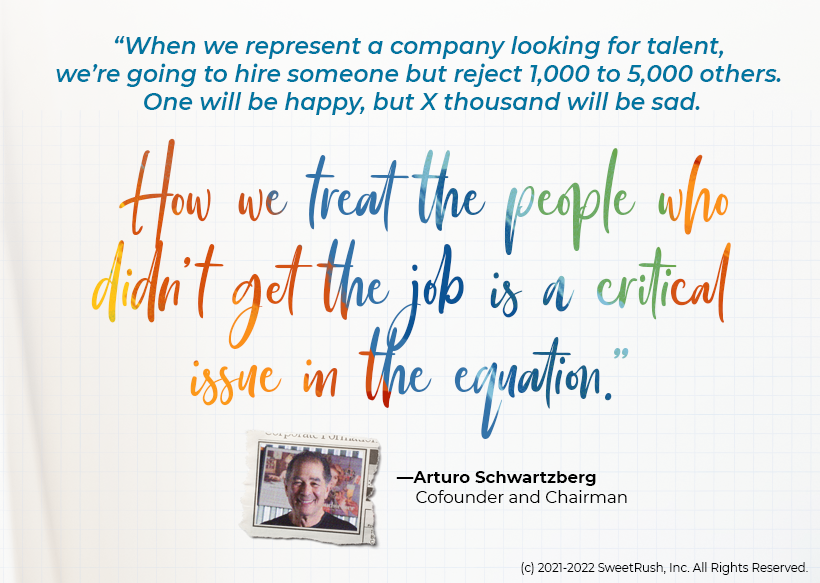
Rejection stings. It hurts even more when we ghost a candidate after a great interview—or never acknowledge their application at all.
Mistreating candidates not only hurts their feelings, it undermines our mission to do good in the world. Candidates who feel burned are less likely to reapply in the future, recommend our organization to others, or do business with us. However, they’re quite likely to share their experience via Glassdoor, other social media, or word of mouth.
A poor candidate experience also costs us money. Even industry leaders feel the pain: Back in 2014, Virgin Media reported a loss of over 7,500 customers and $6 million in revenue due to poor candidate experience.
Handling every application with care isn’t just the right thing to do; it’s the right way to do business.
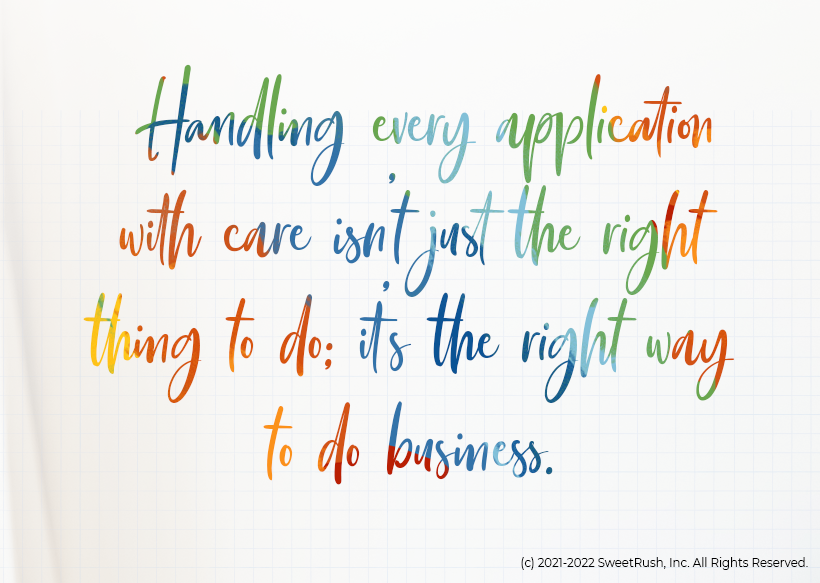
Here’s how to deliver the golden “no”:
 Acknowledge applications immediately. A one-line automated reply is enough to reassure them that their carefully written cover letter hasn’t disappeared into the void.
Acknowledge applications immediately. A one-line automated reply is enough to reassure them that their carefully written cover letter hasn’t disappeared into the void. Keep them updated on every step of the process. Doing so would make 81% of applicants happy—even when the news is bad.
Keep them updated on every step of the process. Doing so would make 81% of applicants happy—even when the news is bad. Follow up with a personal note to candidates you’ve interviewed but have decided not to pursue. Whenever possible, try to provide a reason, e.g., “We loved your enthusiasm, but we’ve decided to go with a more experienced candidate,” or “Your writing sample was strong, but we’re looking for a less academic tone.” If they follow you on social media, they’ll probably see whom you’ve chosen—don’t make them guess what the new hire has that they don’t.
Follow up with a personal note to candidates you’ve interviewed but have decided not to pursue. Whenever possible, try to provide a reason, e.g., “We loved your enthusiasm, but we’ve decided to go with a more experienced candidate,” or “Your writing sample was strong, but we’re looking for a less academic tone.” If they follow you on social media, they’ll probably see whom you’ve chosen—don’t make them guess what the new hire has that they don’t. Thank them for their time and interest. Without folks like them, we wouldn’t have such a great pool of talent to choose from. We owe our gratitude to each and every person who jumps in.
Thank them for their time and interest. Without folks like them, we wouldn’t have such a great pool of talent to choose from. We owe our gratitude to each and every person who jumps in. Invite every candidate to stay in touch—and reapply for future openings. Today’s “almost” can become tomorrow’s top candidate—don’t burn that bridge!
Invite every candidate to stay in touch—and reapply for future openings. Today’s “almost” can become tomorrow’s top candidate—don’t burn that bridge!
Prompt, warm communication adds transparency and humanity to a process that too often feels opaque and intimidating. Our ability to apply the Golden Rule at these vulnerable moments speaks volumes about our character—and our culture.
Print More Golden Tickets
Let’s move to a happier topic: the invited guests. And because the virtual recruiting process is so easy to get right when the news is good, we’re going to take a huge leap over it here.
Let’s assume that you’ve whittled your choices down to two strong contenders. Both seem perfect: They have the right skills, the right experience, the right attitude and, darn it, you like them. You’re just about ready to flip the coin when one candidate expresses a need for flexibility. (See below.)
Deal or No Deal?
You’re hiring for a full-time, permanent, salaried role. Which of the following statements are dealbreakers?
I can only work 25 hours per week.
I can only work six months out of the year.
I can work 40 hours over the course of the week, but I need a flexible schedule.
I can only work 20 hours through September, but then I can jump up to full time.
I need to take a leave of absence in three months.
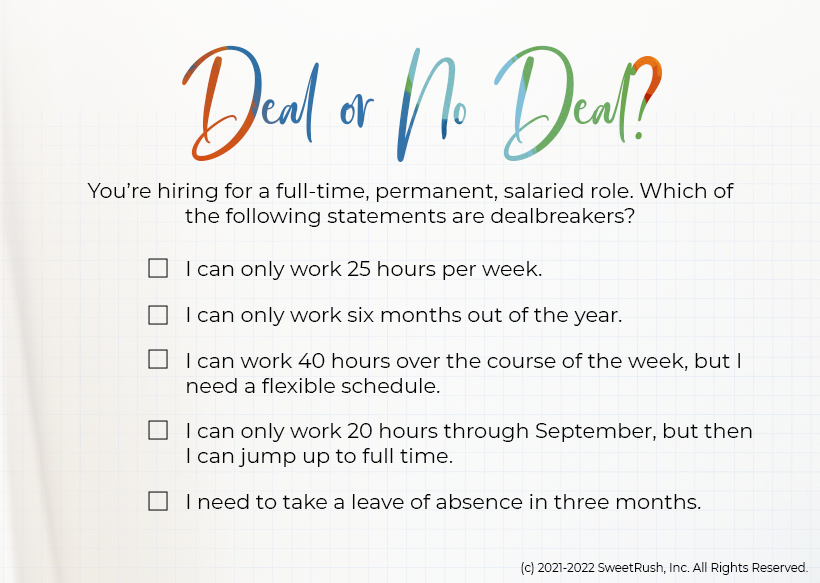
Trick question, right? The role is full-time, permanent, and salaried, so every one of these statements is a dealbreaker. The Golden Ticket goes to the other candidate by default.
Not so fast!
Friends, the position may well be designated in “the system” as a year-round, 40-hour, immediate-start, salaried role. But one of two great candidates has just expressed that this work model won’t work for them. And they’ve been honest with you up front, which speaks volumes about their character.
Sure, we could deliver a Golden No. But what if we thought differently about the way we fill the position? What if we could get beyond the binary thinking of full- versus part-time?
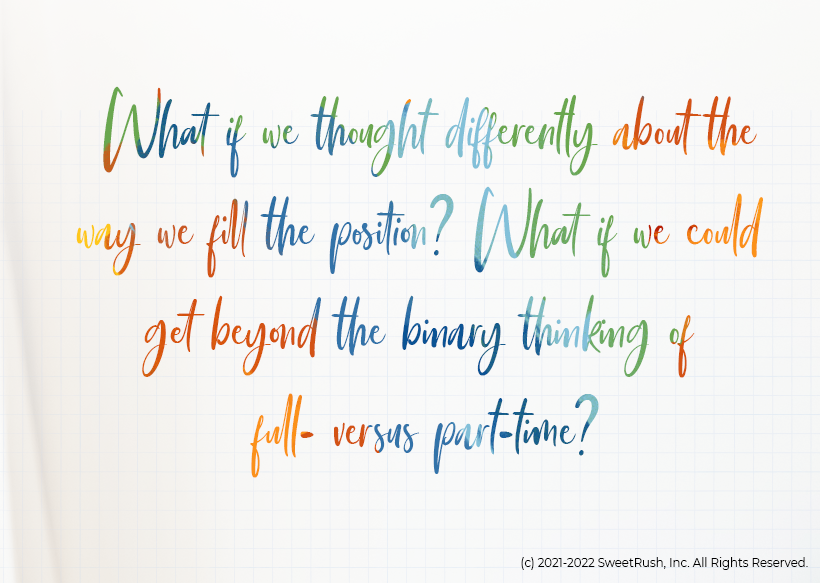
Offer Contract Work
Contract and project-based work is one way to break out of binary thinking and invite more professionals into our community of practice. These options help us meet the needs of professionals who have seasonal or sporadic availability while also filling critical positions on our clients’ teams—and our own. If you’ve attracted a few great candidates who don’t want to give up the freelance life, consider changing the role—not the candidates.
Removing these constraints not only helps you get the best talent pool; it opens opportunities for people who need flexibility due to caretaking, health, and family concerns. And because the bulk—31.65 hours per week on average—of caretaking falls upon women, remote work also helps to keep women in the workplace.
Part of our responsibility as members of a human-centered organization is to remove barriers that prevent our teams from resembling the wider community. The five million female employees who dropped out of the workforce over the past year are a tremendous—and avoidable—loss.
Destroy Binary Thinking
Throughout the pandemic, our major life stressors have been amplified: We’ve been packed tighter, stretched thinner, and held in a perpetual state of limbo. With the collective burnout we’ve experienced, our normal rules for vacation time, recovery time, onboarding time, and an eight-hour workday simply do not apply.
That’s why we need to move beyond the rigid binaries of full- versus part-time and all or nothing. Removing those constraints from our remote recruiting practice helps us invite a larger pool of candidates into our talent pool—and say yes to more of them. And by providing more people with a means of earning money for practicing their craft—and developing it further—we do more good in the world.
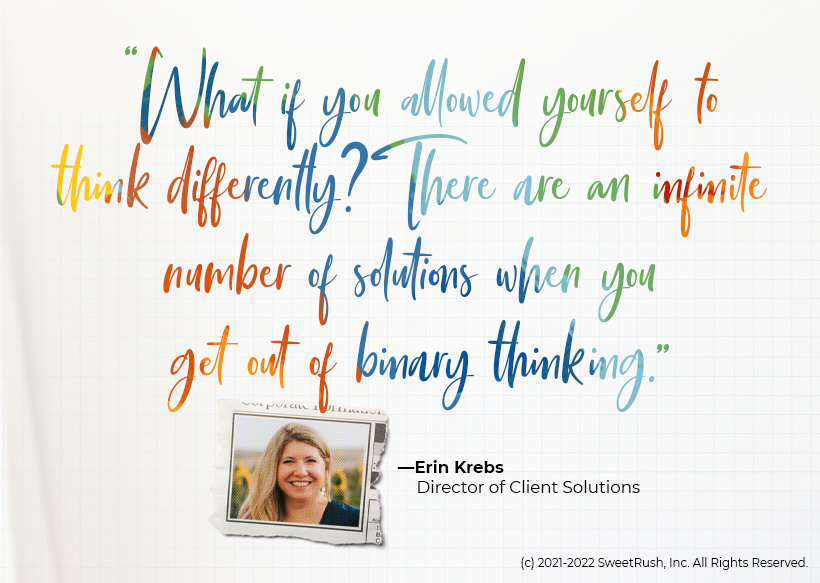
Employee Retention: Play the Long Game
One of our managers encountered all three of the following situations over the past year and a half.
How do you think she responded?
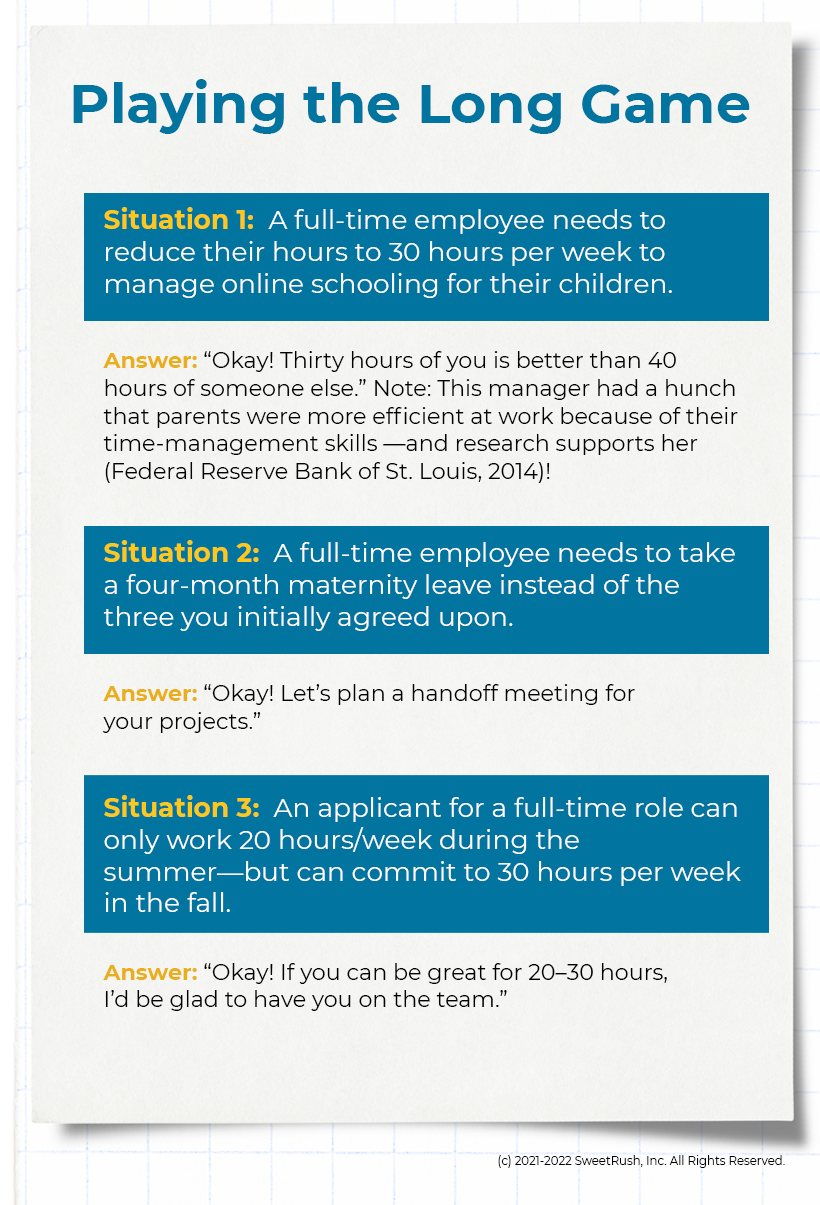
How surprised were you by the manager’s reactions to these situations?
A traditional manager might have responded by pointing out the mismatch between the employee and the business need—and cutting ties. But thinking outside the binary, as our manager did, allowed her to retain her employees over the long term. Her team of highly skilled, senior-level knowledge workers is hard to replace—but she knows she can count on their loyalty and commitment.
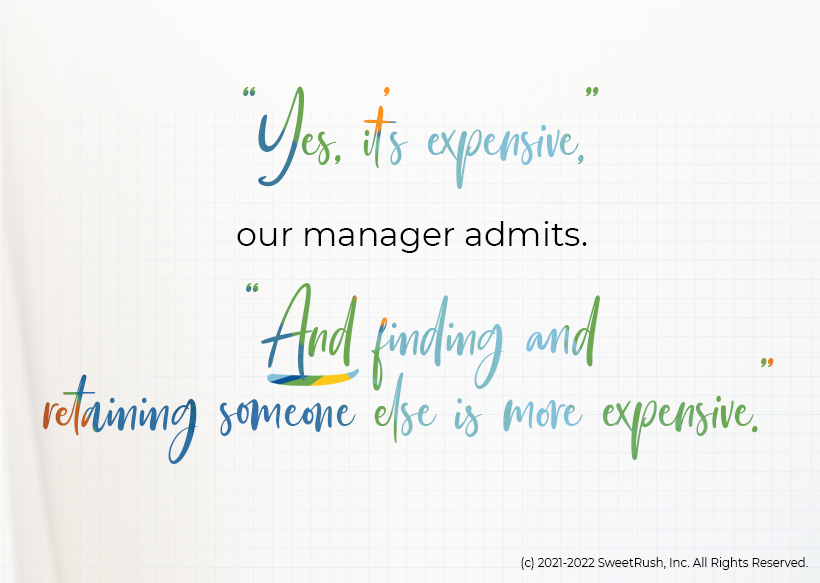
Virtual Recruiting and Diversity, Equity, Inclusion, and Belonging
We’ve saved the best for last on this whirlwind tour of remote recruiting: Meeting our candidates remotely has been a lifeline for us in our journey toward inclusion. It’s freed us from the constraints of a single geographic area and given us teammates who span 12 countries and every time zone. It’s helped us hire extremely talented people whose bodies and brains aren’t well served by a traditional office. And it helps us eliminate a lot of the “noise” that isn’t relevant to the role: details such as a candidate’s fashion sense, posture and gestures, and what their body looks like or can do.
We’re so grateful to have a way to cut through that noise and broaden the definition of that elusive quality we call SweetRush. (Yes, we use it as an adjective!) And it’s not just a nice-to-have: As the biggest drivers of social change, organizations have a significant responsibility to employ a workforce that reflects the larger community.
Beyond a Firm Handshake: The Business Benefits of Virtual Recruiting
If you’re used to evaluating candidates by the firmness of their handshake, virtual recruiting may feel like a challenge. Trusting candidates when you can only see their head and shoulders—and whom you might never meet in person—may feel awkward at first.
But the benefits of virtual recruiting far outweigh the costs. Seeking candidates across regional—even national—boundaries opens your organization to a wider and more diverse talent pool. People who bring entirely new ways of thinking and working to the table make your team smarter and more innovative.
Having the right people for the job, wherever they are in the world, boosts managers’ confidence in their teams—and helps them extend trust to their employees. (Here’s why a great virtual management practice begins with trust.)
Ready to learn more about virtual recruiting and management practices that attract the best people—and keep them happy for the long term? Check out our eBook, It’s All About Your People! Embracing Human-Centered Business, Workplace Culture, and Learning Design. You’ll find plenty of lessons from our two decades as a human-centered organization—and decade-plus as a fully remote team.




